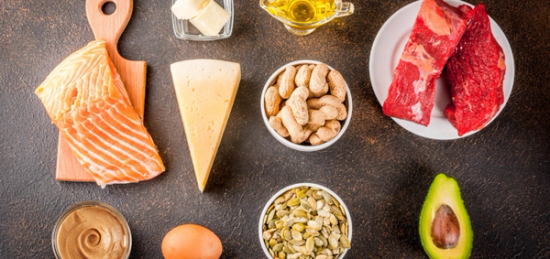By: Jada Linton, RDN, LD
As a Registered Dietitian Nutritionist (RDN) I enjoy tasting the benefits of delicious foods in moderation. In doing so, I try to stay away from diet mentality. It is hard to recommend a diet that restricts amazing food groups. The keto diet conversation usually stems from mind-blowing weight loss stories. Is the keto diet the topic of conversation between friends and family? Let's learn more about the Keto diet, so you will know the facts!
The Keto Diet
The keto diet is a high-fat, normal-protein, low-carb diet. There are two types of carbs. Simple carbs include foods such as cakes, cookies, pies, etc. Complex carbs include legumes, whole grains, and vegetables. The complex carbs provide your body with vitamins, minerals, and fiber [1].
The History
The keto diet has been around for over 100 years. The ketogenic diet was introduced by modern physicians as a treatment for epilepsy in the 1920s [2]. Fasting and other dietary regimens have been used to treat epilepsy since at least 500 BC. Nutrition treatment is an alternative for children with epilepsy on multiple antiepileptic drugs [2]. Medical nutrition therapy for disease states like epilepsy can be very beneficial.
So why are so many people raving about the keto diet? Weight loss. The side effects include weight loss, high levels of LDL, and elevated total cholesterol [3]. Additional side effects are constipation, diarrhea, vomiting, and stomach pain.
Dr. Marcelo Campos from Harvard University reported that we do not know of the long-term effects of the keto diet. Dr. Campos also mentioned that a balanced unprocessed diet rich in very colorful fruits and vegetables, lean meats, fish, whole grains, nuts, seeds, olive oil, and lots of water seem to have the best evidence for a long, healthier, vibrant life [4].
The Food
Now we know more about the keto diet, but what is allowed in the diet? The options include meat, fish, butter, eggs, cheese, heavy cream, oils, peanuts & nuts, avocados, seeds, and low-carb vegetables.
Scientific evidence suggests but does not prove that eating 1.5 oz per day of most nuts, including peanuts, as part of a diet low in saturated fat and cholesterol may reduce the risk of heart disease. Peanuts are a great addition to your plate, besides being nutrient dense, the fiber peanuts contain help keep you full!
In contrast, nearly all carb sources are eliminated in the keto diet, including grains, rice, beans, potatoes, sweets, milk, cereals, and fruits.
Dietary Guidelines suggest the following [5]:
- Follow a healthy eating pattern across the lifespan. Choose a healthy eating pattern at an appropriate calorie level to help achieve and maintain a healthy body weight, support nutrient adequacy, and reduce the risk of chronic disease.
- Focus on variety, nutrient density, and amount. choose a variety of nutrient-dense foods across and within all food groups in recommended amounts. To meet nutrient needs within calorie limits, choose a variety of nutrient-dense foods across and within all food groups in recommended amounts.
- Limit calories from added sugars and saturated fats and reduce sodium intake. Cut back on foods and beverages higher in these components to amounts that fit within healthy eating patterns.
- Shift to healthier food and beverage choices and support healthy eating patterns for all. Choose nutrient-dense foods and beverages across and within all food groups in place of less healthy choices.
For guidance on eating patterns that support good health click here.
The Bottom Line
Sometimes diets that are very restrictive are not sustainable for the long term. Click here to learn more about restrictive diets. The keto diet for weight loss requires additional research. If you decide to try the keto diet, consult with a medical professional first.
Sometimes the best way to work on weight control is not to diet at all, but to make a healthy lifestyle shift. Dedicate half of your plate to colorful fruits and vegetables, vary your protein options, choose whole grains, limit your salt and fat intake, and decrease added sugar consumption [5]. Balancing each plate is a great way to begin a healthy lifestyle!
References:
[1] Hurd, R. (n.d.). Complex carbohydrates: MedlinePlus Medical Encyclopedia Image. Retrieved April 4, 2019, from https://medlineplus.gov/ency/imagepages/19529.htm
[2] Wheless, J. W. (2008). History of the ketogenic diet. Epilepsia, 49(s8), 3–5. https://doi.org/10.1111/j.1528-1167.2008.01821.x
[3] Rogovik, A. L., & Goldman, R. D. (2010). Ketogenic diet for treatment of epilepsy. Canadian Family Physician, 56(6), 540–542. Retrieved from https://www.ncbi.nlm.nih.gov/pmc/articles/PMC2902940/
[4] Campos, M. (2017, July 27). Ketogenic diet: Is the ultimate low-carb diet good for you? Retrieved April 4, 2019, from https://www.health.harvard.edu/blog/ketogenic-diet-is-the-ultimate-low-carb-diet-good-for-you-2017072712089
[5] U.S. Department of Health and Human Services and U.S. Department of Agriculture. (2015). 2015 – 2020 Dietary Guidelines for Americans. 8th Edition. From https://health.gov/dietaryguidelines/2015/guidelines/.
